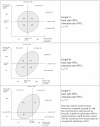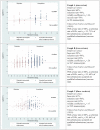The usefulness of peer review for selecting manuscripts for publication: a utility analysis taking as an example a high-impact journal
- PMID: 20596540
- PMCID: PMC2893207
- DOI: 10.1371/journal.pone.0011344
The usefulness of peer review for selecting manuscripts for publication: a utility analysis taking as an example a high-impact journal
Abstract
Background: High predictive validity--that is, a strong association between the outcome of peer review (usually, reviewers' ratings) and the scientific quality of a manuscript submitted to a journal (measured as citations of the later published paper)--does not as a rule suffice to demonstrate the usefulness of peer review for the selection of manuscripts. To assess usefulness, it is important to include in addition the base rate (proportion of submissions that are fundamentally suitable for publication) and the selection rate (the proportion of submissions accepted).
Methodology/principal findings: Taking the example of the high-impact journal Angewandte Chemie International Edition (AC-IE), we present a general approach for determining the usefulness of peer reviews for the selection of manuscripts for publication. The results of our study show that peer review is useful: 78% of the submissions accepted by AC-IE are correctly accepted for publication when the editor's decision is based on one review, 69% of the submissions are correctly accepted for publication when the editor's decision is based on two reviews, and 65% of the submissions are correctly accepted for publication when the editor's decision is based on three reviews.
Conclusions/significance: The paper points out through what changes in the selection rate, base rate or validity coefficient a higher success rate (utility) in the AC-IE selection process could be achieved.
Conflict of interest statement
Figures


Similar articles
-
Write a scientific paper (WASP): Editor's perspective of submissions and dealing with editors.Early Hum Dev. 2019 Feb;129:93-95. doi: 10.1016/j.earlhumdev.2018.12.007. Epub 2018 Dec 19. Early Hum Dev. 2019. PMID: 30578111
-
Predicting future citation counts of scientific manuscripts submitted for publication: a cohort study in transplantology.Transpl Int. 2019 Jan;32(1):6-15. doi: 10.1111/tri.13292. Epub 2018 Jul 22. Transpl Int. 2019. PMID: 29907979 Free PMC article.
-
Manuscript Review at the Journal of Pediatric Gastroenterology and Nutrition: The Impact of Reviewers on Editor Decisions.J Pediatr Gastroenterol Nutr. 2021 Nov 1;73(5):567-571. doi: 10.1097/MPG.0000000000003208. J Pediatr Gastroenterol Nutr. 2021. PMID: 34173794
-
Review of Journal of Cardiovascular Magnetic Resonance (JCMR) 2015-2016 and transition of the JCMR office to Boston.J Cardiovasc Magn Reson. 2017 Dec 28;19(1):108. doi: 10.1186/s12968-017-0423-x. J Cardiovasc Magn Reson. 2017. PMID: 29284487 Free PMC article. Review.
-
The distribution of forensic journals, reflections on authorship practices, peer-review and role of the impact factor.Forensic Sci Int. 2007 Jan 17;165(2-3):115-28. doi: 10.1016/j.forsciint.2006.05.013. Epub 2006 Jun 19. Forensic Sci Int. 2007. PMID: 16784827 Review.
Cited by
-
Is expert peer review obsolete? A model suggests that post-publication reader review may exceed the accuracy of traditional peer review.Surg Endosc. 2012 Aug;26(8):2275-80. doi: 10.1007/s00464-012-2171-1. Epub 2012 Feb 21. Surg Endosc. 2012. PMID: 22350231
-
Views on the peer review system of biomedical journals: an online survey of academics from high-ranking universities.BMC Med Res Methodol. 2013 Jun 7;13:74. doi: 10.1186/1471-2288-13-74. BMC Med Res Methodol. 2013. PMID: 23758823 Free PMC article. Review.
-
A prospective study on an innovative online forum for peer reviewing of surgical science.PLoS One. 2017 Jun 29;12(6):e0179031. doi: 10.1371/journal.pone.0179031. eCollection 2017. PLoS One. 2017. PMID: 28662046 Free PMC article.
-
The validity of peer review in a general medicine journal.PLoS One. 2011;6(7):e22475. doi: 10.1371/journal.pone.0022475. Epub 2011 Jul 25. PLoS One. 2011. PMID: 21799867 Free PMC article.
-
Alternatives to peer review: novel approaches for research evaluation.Front Comput Neurosci. 2011 Dec 14;5:56. doi: 10.3389/fncom.2011.00056. eCollection 2011. Front Comput Neurosci. 2011. PMID: 22174702 Free PMC article.
References
-
- Sense About Science. Peer review and the acceptance of new scientific ideas. London, UK: Sense about Science (working party on equipping the public with an understanding of peer review); 2004.
-
- Stossel TP. Refinement in biomedical communication - a case study. Science Technology & Human Values. 1985;10:39–43.
-
- Bornmann L, Daniel H-D. Selecting manuscripts for a high impact journal through peer review: a citation analysis of Communications that were accepted by Angewandte Chemie International Edition, or rejected but published elsewhere. Journal of the American Society for Information Science and Technology. 2008;59:1841–1852.
-
- Bornmann L, Daniel H-D. The effectiveness of the peer review process: inter-referee agreement and predictive validity of manuscript refereeing at Angewandte Chemie. Angewandte Chemie International Edition. 2008;47:7173–7178. - PubMed
-
- Bornmann L, Daniel H-D. Extent of type I and type II errors in editorial decisions: a case study on Angewandte Chemie International Edition. Journal of Informetrics. 2009;3:348–352.
Publication types
MeSH terms
LinkOut - more resources
Full Text Sources

